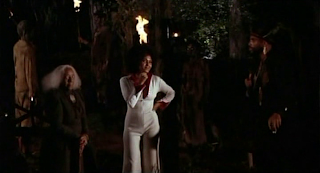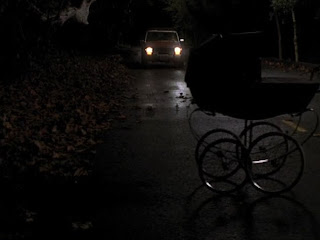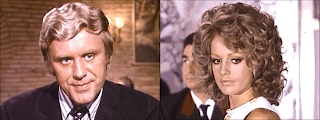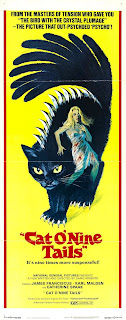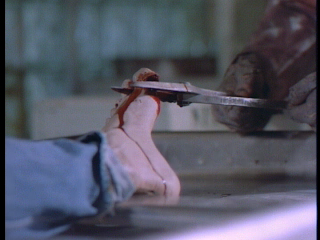Roberto Tobias, a drummer in a rock band, has been noticing a man following him for about a week. When he sees the man late at night after a band practice, he follows and then confronts him in an abandoned theatre. The man pulls a switchblade, and in the struggle he is stabbed and seems to die. As Roberto stands over the body with the bloodied knife in his hand, a spotlight is turned on him from the gallery where a masked figure starts taking photographs of him. He flees, but soon he starts receiving packages from the mysterious witness - the dead man's wallet, photographs of the murder, and worse. He confesses everything to his wife Nina, who urges him to run away with her, but he refuses as he's scared that he'll end up in prison for murder. Then their maid discovers what's going on and tries blackmail; when she turns up dead it's clear that Roberto and Nina are caught in a trap that neither will be able to escape unscathed.

On the advice of his friend God (played by slapstick comedian Bud Spencer) Roberto hires Gianni Arrosio, a flamboyantly gay private investigator who swiftly manages to uncover the identity of the blackmailer. Poor Gianni should have realised that if you want to survive a murder mystery, you need to do that right at the end of the story...
This is a fascinating movie. In some ways it seems slapdash and inconsistent, and there are some dreadful comic relief bits that really don't work, but even these scenes are closely linked to the movie's thematic concerns. It has an elaborate visual style that at first seems gratuitous but which turns out to be centered around revealing the themes of the movie. The murder mystery itself is extremely difficult to work out, cheats several times and requires the killer to pretty much be a mind-reader, but its resolution really clarifies everything that the movie is doing.

It's very much the transitional movie between his first movies, which were stylish but very tightly written and plot-driven, into his later movies, which were much more personal and often abandoned conventional plotting in favour of his visual and thematic obsessions. This is blatantly signalled in the scene where Roberto enters the theatre at the start - the camera passes through several layers of deep red curtains, in anticipation of what was to be his breakthrough movie three years later...
In short, this is the movie which reveals that Dario Argento's main influence is less Alfred Hitchcock, as is commonly presumed, and more Michaelangelo Antonioni. It even references (and parodies) the ending of
Zabriskie Point. This connection to Antonioni would become even more clear when he made
Deep Red.... but we'll get to that in a few weeks.
Four Flies on Grey Velvet is a movie about gender, sexuality and repression; as with every Argento movie it's also about perception, and how what you see is not necessarily the truth. I'm going to give away a few salient points now (including the identity of the killer and what really happened in the opening scene) so if you haven't seen the movie and want to watch it without foreknowledge, now is the time to stop reading.
Watching
Four Flies a second time was more interesting because knowing that the opening scene was a setup and that the "murder" was fakes with a trick knife and a blood bag, and that the killer is actually Nina, makes everything play very differently. As the final scene reveals, Nina was raised as a boy by an unhinged father, and is played by the androgynous American actress Mimsy Famer, who is spectacular in the role. This makes the scene where she kills Gianni in an unisex toilet very interesting; usually a scene of a gay man being killed in a toilet would seem homophobic, but not this time.

Gianni is actually the smartest and most sympathetic character in the whole movie, and although his mannerisms are rather stereotyped he is a vast improvement over the gay stereotypes in most movies of the period.
Four Flies actually puts Argento at three for three in featuring sympathetic gay characters in his movies, after the art dealer in
The Bird with the Crystal Plumage and the rude yet likable Dr. Braun in
The Cat o' Nine Tails, and according to Argento's biographer Alan Jones he wanted to make a movie with only gay characters but the idea was vetoed by his producers.
Comic relief scenes involving a mailman delivering pornography to the wrong address are cringingly unfunny, but serve to highlight the sexuality/repression theme - especially as the person who receives them in error is a sexually repressed woman who is later revealed to be secretly in love with Roberto.
Speaking of Roberto, he is a very unlikable and even obnoxious character. After seemingly commiting murder, his only reaction is fear of being caught. He treats Nina very badly (which, as it turns out, plays directly into her obsessions) and thoughtlessly cheats on her with her young cousin. He lashes out at the mailman, mistaking him for the blackmailer and gives him a sound thrashing before realising his mistake.
Like Nina, Roberto is an androgynous figure, and despite the homophobia he displays upon first meeting Gianni (in a scene that playfully challenges the audience's own homophobia) many of his interactions with other male characters have a homoerotic subtext to him. It's interesting that, as played by David Brandon, he closely resembles Argento himself.
Nina's motivation for tormenting Roberto turns out to be very twisted indeed. She seduced and married him specifically because he bears a very close physical resemblence to her dead father. He had died while she was committed to a psychiatric institution, so she was looking for someone to torment and murder in his place. In the end, as she is about to kill him, he is saved by divine intervention as God actually bursts into the room and chases her off!

God himself is an interesting character. He's sourced from the novel
The Screaming Mimi by Frederic Brown, which was the uncredited source material that
The Bird with the Crystal Plumage had, er, borrowed from. He's a big burly man with a black beard who lives in a shack by the river and lives off raw fish. He's actually introduced with a chorus of "Hallelujah," in an example of the movie's ham-fisted sense of humour. Like many homeless people in movies, God is deeply philosophical. He has a sidekick called The Professor, who constantly quotes from the Bible. I must confess that I'm unsure of the exact significance of these irreverently religious figures.
Four Flies on Grey Velvet stretches this kind of giallo about as far as it can go. It's pretty clear that Argento was unlikely to want to continue in this vein, and with his next movie he moved out of the thriller genre entirely for the only time in his career to date, with the spectacularly unsuccessful
The Five Days. However first he was engaged to produce and host a series of four thrillers for the Italian television netowkr RAI, called
The Door Into Darkness, and ended up writing and directing two of these himself. In the manner of
Alfred Hitchcock Presents, these were to make Argento into a genuine star in his own country, and we'll look at the first of these next week -
The Tram, which was actually based on an episode he cut out of the script of his first movie.









